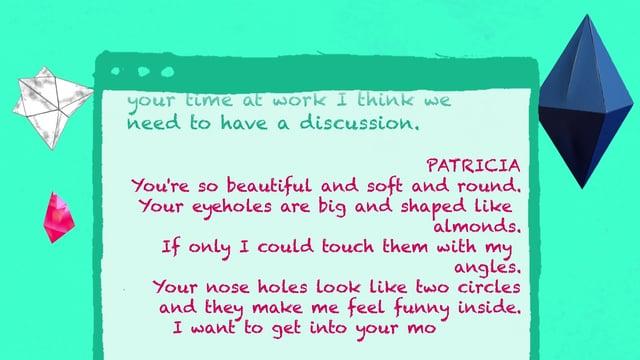Ariel Evans
This is the set-up of Primitive Games (Birgit Rathsmann’s three web episodes for Pastelegram): Patricia, an animator, used rendering software to create three shapes. The shapes gain consciousness yet remain inside the computer. To learn about humans they glean data from the internet.
The Shapes (Blue, Red and White) want to understand humans. Blue is in love with Patricia and discusses sex and romance with Red and White. Their conversations are naïve, and because the Shapes know only Internet clichés they are also often canned. When Red tells Blue, “You’re a beautiful shape. You need to stop looking for approval from the outside world and start realizing what an amazing shape you are,” the advice echoes the platitudes of clickbait dating advice sites. It’s funny, too, how the Shapes struggle to understand human bodies and sex acts through their own abstract geometries--"mouth holes" touch and bodies "click like Legos"--while filtered through internet porn. As the nonhuman learns about the human (or really, as the human imagines itself from a nonhuman perspective) both consciousnesses expand. At least the Shapes show us how awkward it is to be human on the Internet, and it’s funny.

The Shapes’ dialogue is unscripted, developed through improv techniques practiced by Rathsmann and three improv partners: Mary Houlihan, Becket Bowes and Lorelei Ramirez. The four artists/comedians discuss the characters’ creation in their group interview with Miriam Katz.
Pastelegram’s eponymous issue surrounding Primitive Games considers improvisational methods as a way to detach from the self. As Viola Spolin noted in “Reminders and Pointers:” “Stage life comes to the player by her giving life to the object. Giving life to the object prevents her from mirroring herself.” Giving life to an object (a robot, a puppet) perhaps creates a perspective that doesn’t wholly reflect you-the-creator. It grows a life beyond its maker. Rathsmann, her collaborators, Katz and Spolin all explore this phenomenon, but the concept appears earlier in Heinrich von Kleist’s writings, also reprinted in this issue. As Jessica D. Brier explains in “Seen, Known, Danced, Spoken: Heinrich von Kleist and the Limits of Being Human,” von Kleist’s texts “explore our understanding of human consciousness and its limits, a condition that often separates us from the physical world and sometimes even alienates us from our own bodies.” Von Kleist recommended bypassing consciousness through spontaneous discourse or automatic gesture, and described the automaton as the purest expression of these possibilities. Yet if we imagine ourselves as two:
Our world is filled with machines and ideas that threaten to separate our consciousness from our corporeal reality and its relations to our surrounding world. The challenge today seems not to identify that separation, as it was for von Kleist, but the ability to put ourselves back together again.
This may be radically creative.
